
3 Simple Psychological Nudges To Boost Your Shopify Store Conversion Rate
The “Add to Cart” click is a good start, but high cart abandonment rates-70-80%-prove the completed purchase is the...
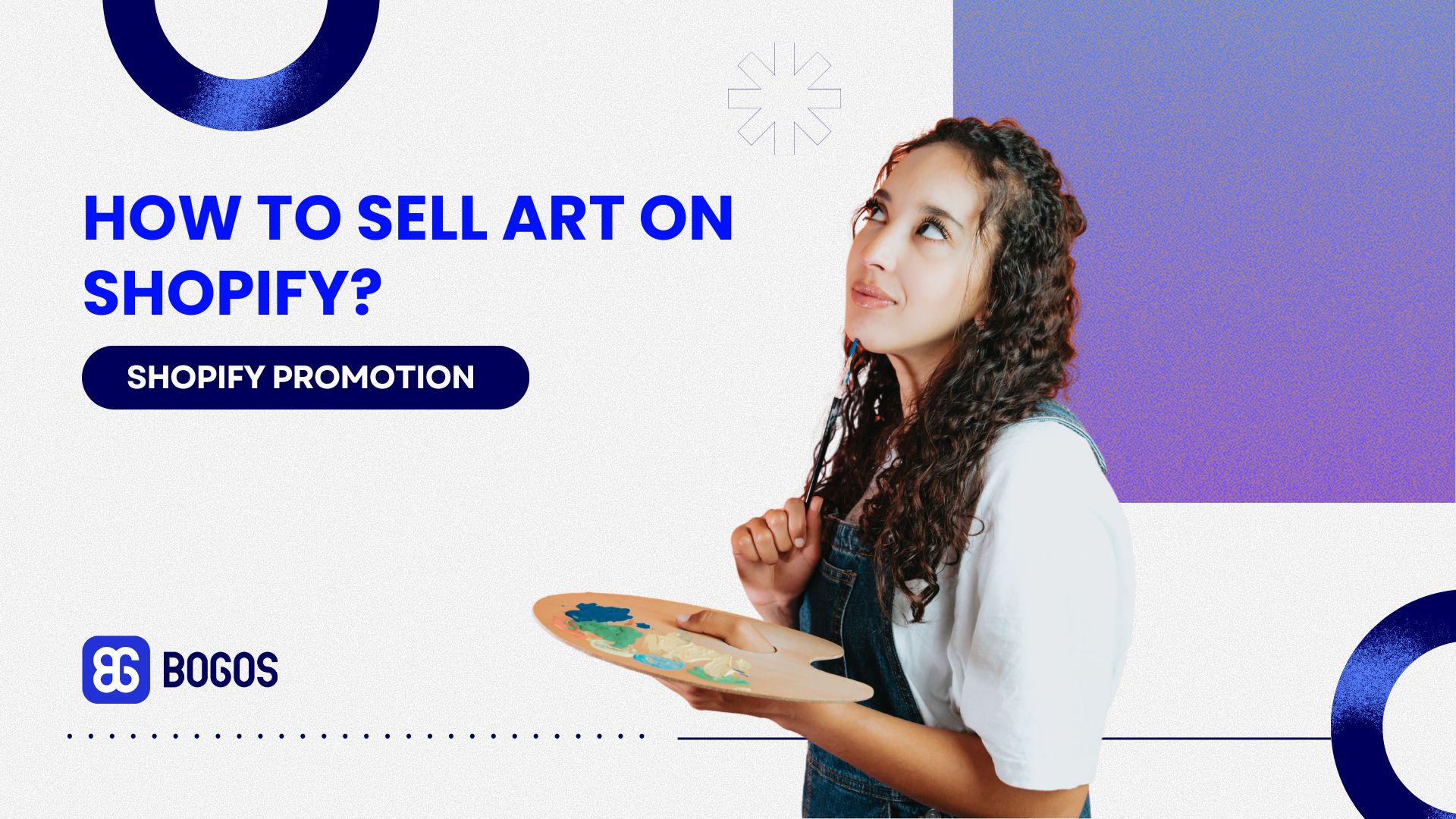
Digital Marketing Specialist
Selling art online is easier than ever, and Shopify provides an excellent way for artists to reach buyers around the world. This guide shows you how to sell art on Shopify step by step – from selecting what type of art to sell to setting up your store and marketing it well.
We’ll cover everything from digital downloads and original pieces to print-on-demand and art-themed products. Whether you’re a new or experienced artist, this article will help you build a store that showcases your work and drives sales.
If you want to turn your passion into a full-time business, sell art on Shopify. Unlike marketplaces like Society6 or Redbubble, Shopify gives you full control over your store design, pricing, branding, and customer experience. Whether you’re selling one-of-a-kind paintings, art prints, or Shopify digital art, this platform is built for artists who want to grow on their terms.
Here’s why Shopify is a top choice for art sellers:
Shopify lets you design your store exactly how you want it. You’re not just uploading products into someone else’s system – you’re creating your own branded art space. This is perfect for artists who want their website to reflect their voice and vision.
When you sell art on Shopify, you set your prices and keep all the profit after payment processing. That’s a big upgrade from Society6, where artists earn just 5–10% royalties, or Redbubble, which deducts account fees based on your monthly earnings. Shopify also avoids platform commissions when you use Shopify Payments.
Shopify supports everything from framed prints to instant downloads. With a leap of print-on-demand integrations, you can automate the production of physical goods. You can use apps like Digital Downloads or Sky Pilot for Shopify digital art, such as downloadable posters or illustration files. It’s an excellent setup for artists who want to sell physical and digital pieces.
Shopify has pricing tiers for every stage of your journey:
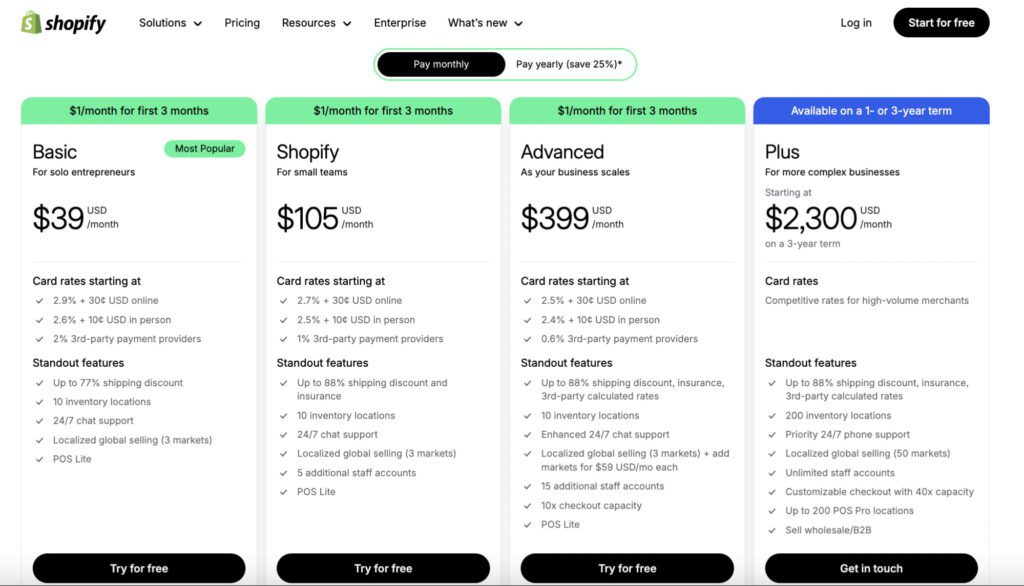
Every plan includes tools for marketing, order management, shipping discounts, and 24/7 support.
When you sell art on Shopify, you don’t just get a storefront – you get real business tools. Email marketing, SEO, blogging, discounts, and upsells help you attract customers. Meanwhile, in-depth analytics show how your Shopify digital art and other products perform across channels.
Who is Shopify not for?
Shopify isn’t the perfect fit for everyone. Here’s when it might not be the best choice:
Paintings and photography may come to mind when you think of selling art on Shopify. This is understandable, as in 2022, paintings accounted for slightly more than 33% of online art sales (Grand View Research, 2023).
Selling into more recent, less crowded categories, however, might help you stand out and increase sales. Below are some suggestions:
Best-selling digital Art (Instant Downloads)
Best-Selling Physical Wall Art
Other Trending Art Products
If you’re an artist looking to turn your creativity into income, Shopify offers several ways to sell your work. The method you choose depends on the type of art you create and how involved you want to be with production and shipping.
Let’s explore the 3 main methods: selling digital products, selling physical art, and using print-on-demand services.
Selling digital files – like printable wall art, illustrations, templates, e-books, or design assets – is one of the easiest ways to monetize your creativity on Shopify. These digital products are delivered instantly after checkout, making them ideal for both artists and buyers looking for speed and convenience.
A great example of this approach is The Drum Broker, a Shopify store that specializes in downloadable sound kits. One of their bestsellers, the Mahogany Segments Vol. 1 Multi-Kit, includes over 450 digital elements like loops, drum breaks, and textures. Customers can listen to previews, make a purchase, and instantly download everything – no shipping, no waiting.
What makes The Drum Broker effective is its simple yet focused layout: a strong landing page, clear product value, and instant delivery. It shows how digital art stores can succeed by making the shopping experience smooth and efficient.
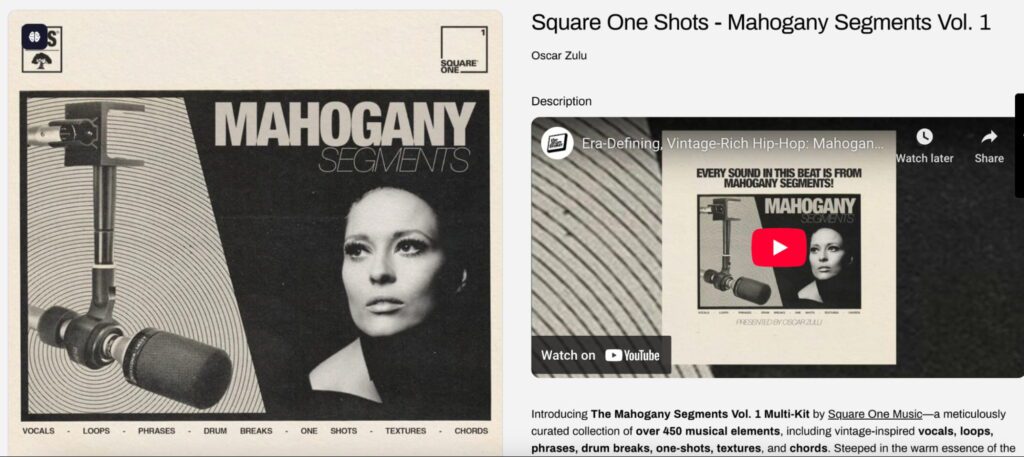
Selling digital art as downloadable products offers several key benefits:
This model is especially suitable for:
Now, let’s break it down into two simple steps.
Start uploading your artwork as a new product in your Shopify admin. Since this isn’t a physical item, you need to update two settings:
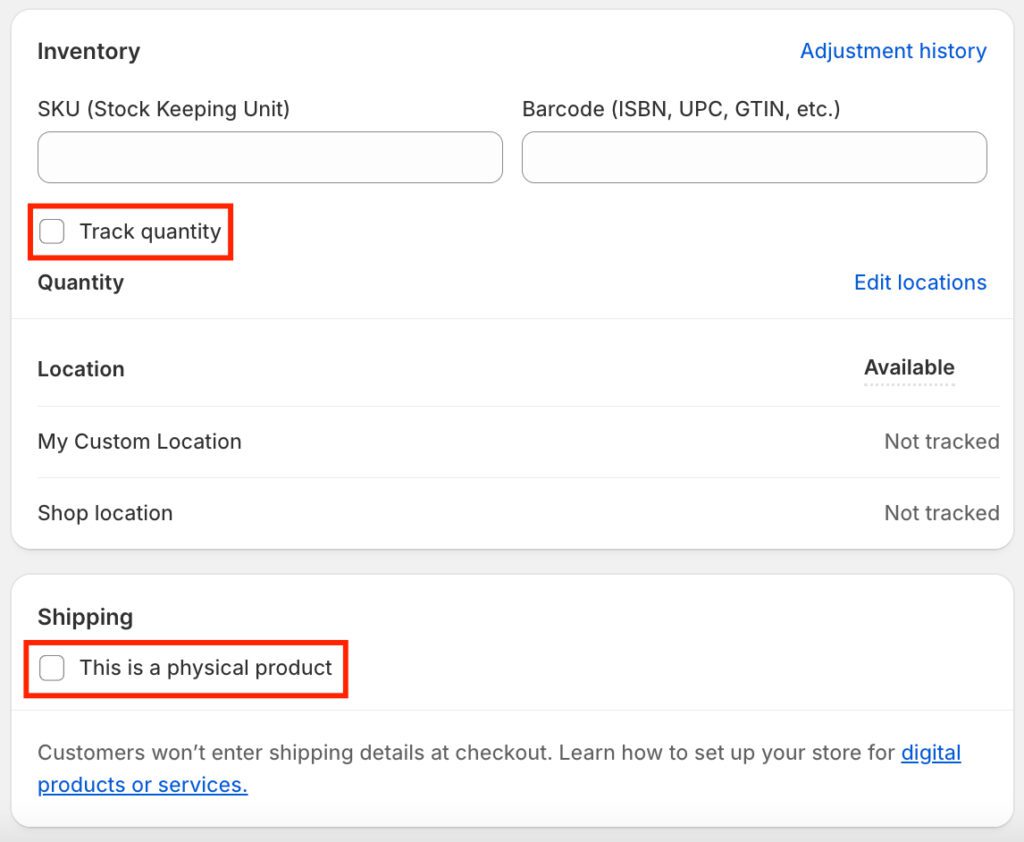
This tells Shopify that the item is digital and doesn’t require shipping. This method is fine if you only sell a few digital files. However, if your store grows or you want to save time, using an app for delivery will make things much easier.
Digital Downloads (Free)
This app allows you to attach files directly to your product. Once a customer completes their purchase, the app automatically sends a download link via email.
You can upload files up to 5GB in size (JPG, PNG, PDF, etc.), choose automatic or manual delivery, and limit the number of downloads per customer. It’s simple, efficient, and perfect for beginners.
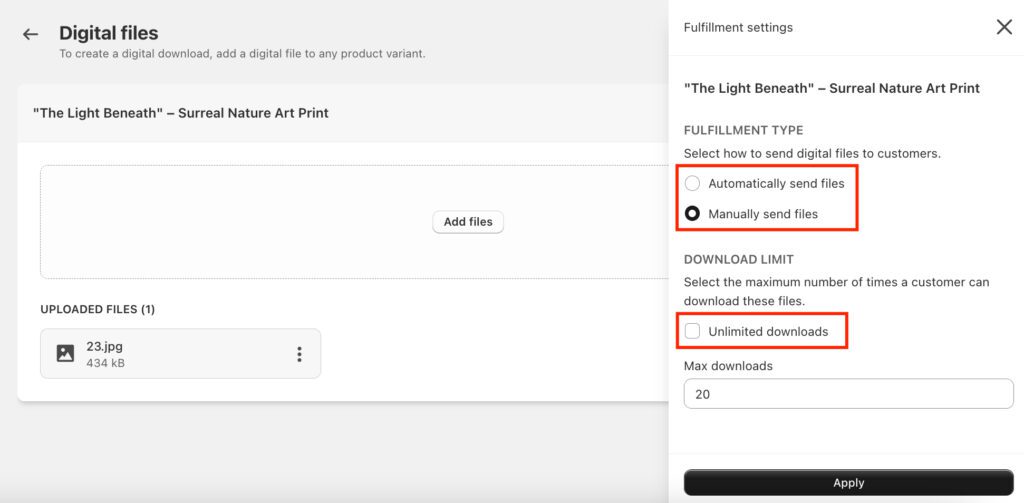
Sky Pilot (Paid)
If you’re selling digital art with more complexity, such as video tutorials or memberships, or you want more branding options, this app is for you. You can upload or connect files, organize them into folders, and set expiration dates or unlimited access.
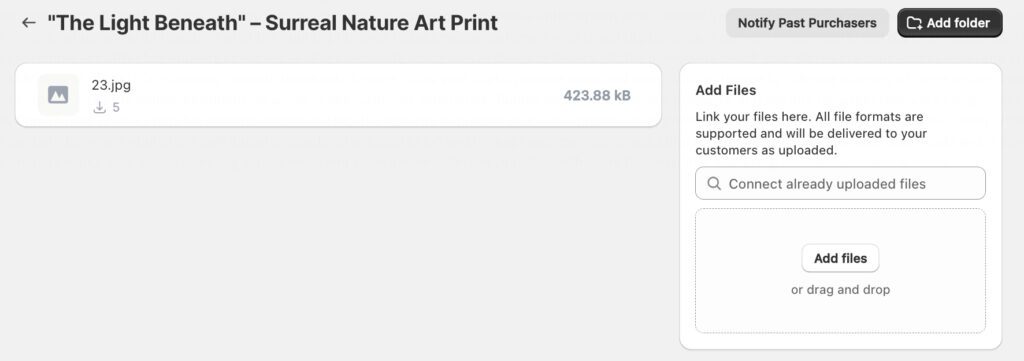
You can also customize the emails customers receive, including your logo and message, and even notify previous buyers when a file is updated.
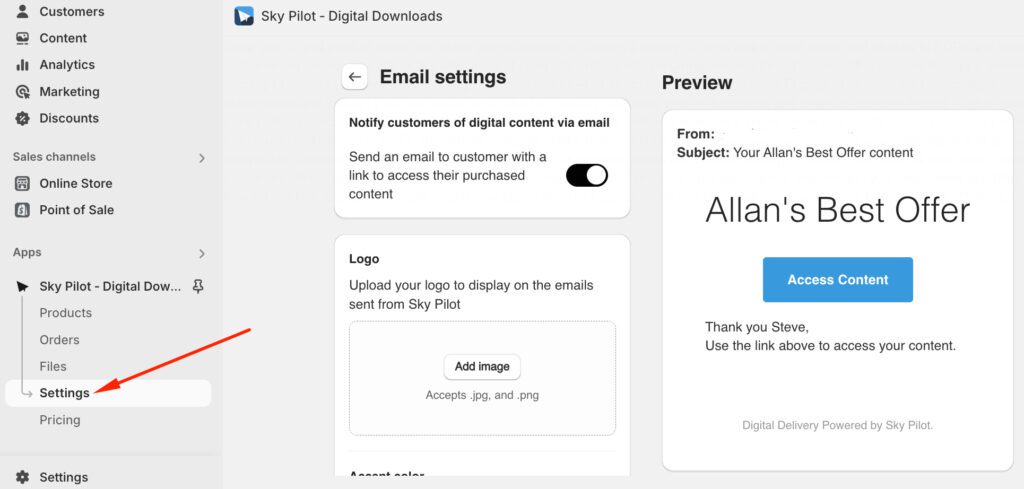
In short, if you’re just starting out, the free Digital Downloads app will handle the basics. But if you need more control and branding features, Sky Pilot is a smart upgrade that can grow with your business.
Selling physical art means delivering real, tangible products like framed prints, posters, or original paintings to customers. Unlike digital files, these artworks need to be produced, packed, and shipped with care. But the reward? A more personal connection and higher perceived value.
A great example is I Love Doodle, the Shopify store by Lim Heng Swee. This store features minimalist and whimsical cat-themed wall art that ships as museum-quality posters. Each product page is thoughtfully built to guide and reassure the buyer:
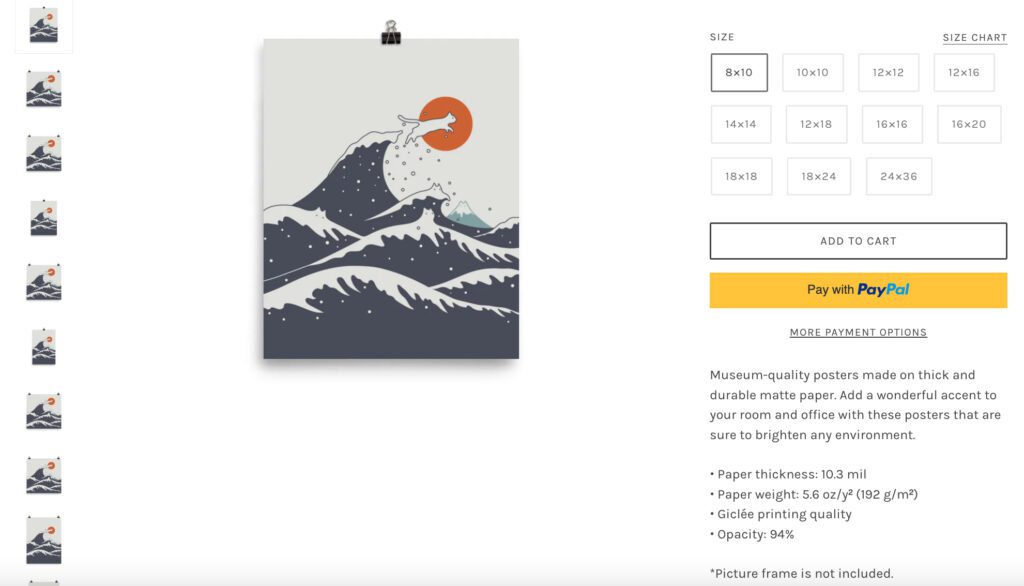
This level of transparency builds trust. Buyers know exactly what they’re getting and how it will look and feel in their home or office.
So, to sell physical art successfully on Shopify:
This approach works well for artists who want more creative control over how their work is printed, packaged, and presented. It also suits customers who value high-quality decor they can physically enjoy — something digital art can’t deliver.
Print-on-demand is a more hands-off way to sell your art, such as printed posters, canvas prints, framed pieces, or even merchandise like mugs or apparel. Services like Printful, ShineOn, or Gelato automatically print your artwork and ship it to the customer after each order – no need to handle inventory or fulfillment.
This is ideal for artists who want to offer more affordable or mass-produced versions of their work. It’s also perfect for buyers of stylish home decor, gifts, or art in multiple formats.
A great example is Crown & Paw, a Shopify store specializing in custom pet portraits. Their process is a perfect showcase of how POD can be used creatively:
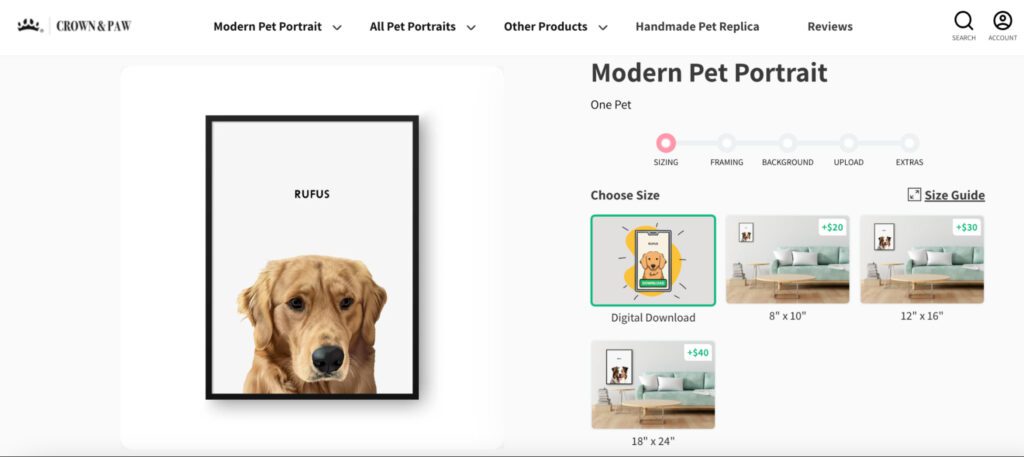
This smooth, automated system means the artist doesn’t need to touch the printing or fulfillment process. Instead, they can focus on creating templates, growing their product range, or running marketing campaigns.
Here’s how a typical POD setup works on Shopify:
With this model, you get the best of both worlds: your art reaches customers worldwide, and you don’t need to worry about production logistics. Just make sure to order a few samples yourself to ensure print quality before scaling up.
Did you know that over 68% of online experiences begin with a search engine? (BrightEdge, 2023). If your store doesn’t show up on Google, you’re missing out on tons of free, targeted traffic.
Here’s how to optimize your store and sell art on Shopify through better SEO:
Email is still one of the most powerful tools to engage customers and drive repeat sales – especially for art stores, where storytelling and personal connection matter.
In 2024, email marketing revenue was predicted to surpass $9.5 billion globally (Statista). In a late 2023 poll, over half of marketers had reported a 100% improvement in their email marketing ROI, proving why email continues to outperform most other channels – even decades after its debut.
To make the most of email marketing for your Shopify art store:
If you want faster results, running paid ads can give your art store the boost it needs – especially during product launches or seasonal promotions.
Where to advertise:
Start with a small budget, test different ad creatives, and focus on high-performing products to scale how you sell art on Shopify.
Offering irresistible deals is a proven way to boost conversion rates, increase cart value, and move more products. One of the most effective tools is the BOGOS Free gift & Bundle (4.9/5 ★ – 2,580+ reviews).
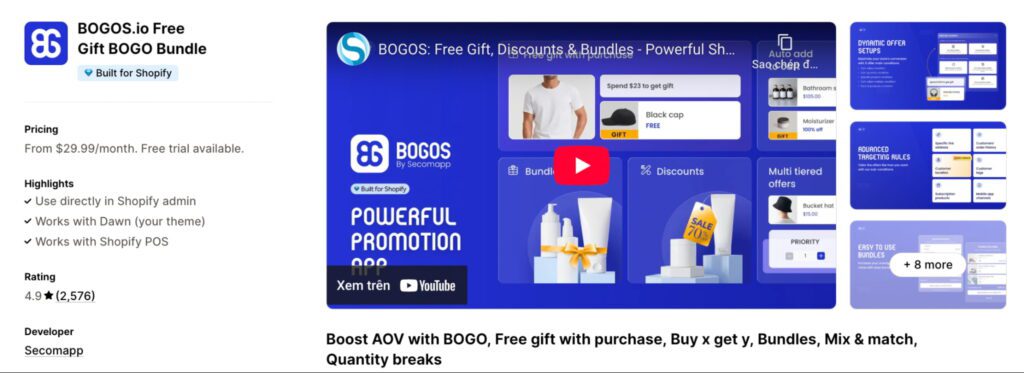
Whether you’re selling art prints or digital downloads, BOGOS.io lets you create:
Why artists love BOGOS.io:
If you’re looking to sell art on Shopify while increasing average order value or clearing out slow-moving inventory, BOGOS.io is a must-have tool. With plans starting at $29.99/month and a 7-day free trial, it’s perfect for both new and seasoned art sellers.
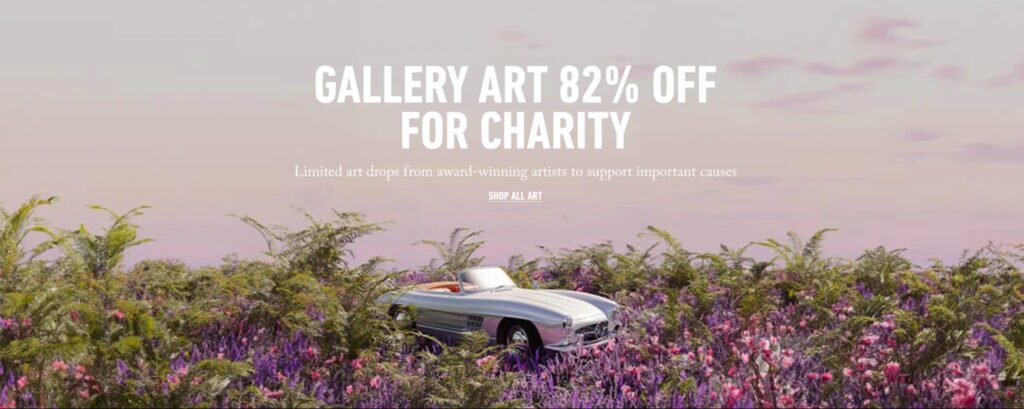
Andy Okay is a mission-driven Shopify art store that connects meaningful art with global causes. Built with a Prestige theme, the site instantly grabs attention with bold headlines like “82% OFF FOR CHARITY” and strong social proof from over 200,000 collectors.
Every artwork is linked to a nonprofit, and urgency is added through countdowns, stock bars, and “ALMOST GONE” tags.
Takeaways:
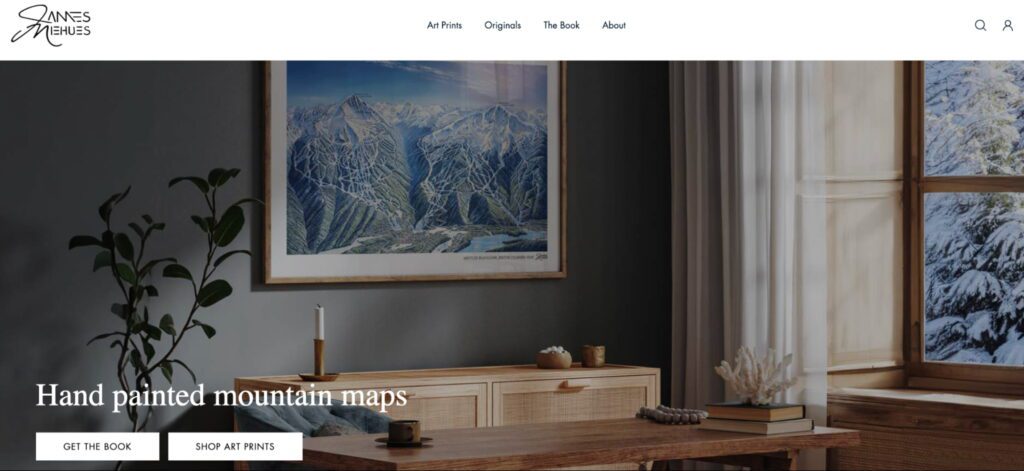
James Niehues’ Shopify art store is a beautiful blend of art and simplicity. It highlights his life’s work – over 30 years of hand-painted ski maps – with clean layouts and large visuals. Product pages keep things uncluttered, while “artwork backstory” sections add emotional value.
His best-selling art book offers an additional product format, and the site includes related suggestions and personal stories to keep visitors engaged.
Takeaways:

Riverry Shopify art store specializes in custom watercolor portraits of pets and homes. The site’s emotional appeal is strong – featuring real pets and their painted portraits. Customization options are clear; buyers can choose style, size, and framing.
Over 100,000 commissions and 70,000+ customer reviews build strong credibility. Gifting categories make it easy for visitors to find art by occasion.
Takeaways:

Artze is a UK-based Shopify art store offering affordable wall art, framed posters, and canvas prints. Despite an extensive catalog, the site stays clean and easy to navigate. The mega menu filters by style, subject, and color, helping users find exactly what they need.
The “Set of 3” concept and quick-buy button simplify browsing and speed up checkout. Product pages offer multiple formats, and Trustpilot reviews build trust.
Takeaways:

Let’s Make Art is a US-based Shopify art store that sells watercolor kits, workbooks, and online lessons. It combines product sales with education, helping users learn how to paint through guided projects and videos.
The layout is calm and easy to browse, with clear menus for categories like monthly packs and tools. The design feels more like a creative community than a typical e-commerce store.
Takeaways:
I hope you find this post inspiring as you get ready to sell art on Shopify and share your talent with the world. The journey won’t always be perfect, but every piece you put out there is a step forward. Keep showing up – and let your art do the talking.
Yes. To sell digital art on Shopify, use apps like Digital Downloads (free) or Sky Pilot (paid). They automatically send download links after purchase. You can upload files like JPG, PNG, PDF, or even videos. Digital products don’t require shipping or inventory, making them ideal for passive income.
If the art is 100% your own, you don’t need a license. But if you use stock elements or collaborate with others, make sure you have proper rights or agreements. Also, clearly state usage rights for digital art (e.g., personal vs. commercial use).
Use Pinterest to share your artwork in high-quality pins linked to your store. Start a simple blog with SEO tips. Offer a freebie (like a small digital print) to grow your email list. Post time-lapse videos or behind-the-scenes reels on Instagram. Use Shopify Collabs to work with micro-influencers.


The “Add to Cart” click is a good start, but high cart abandonment rates-70-80%-prove the completed purchase is the...

Shopify frequently bought together recommendations can boost your average order value by 10-30% by showing customers complementary products they’re...

Summary Is your Shopify store making the most of product add-ons? Upselling add-ons is one of the most effective...
